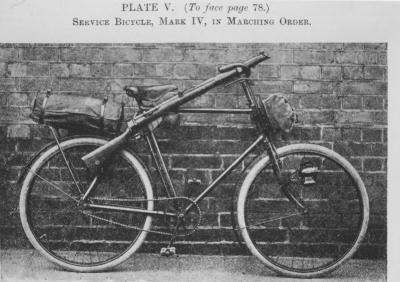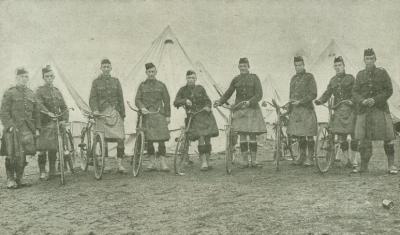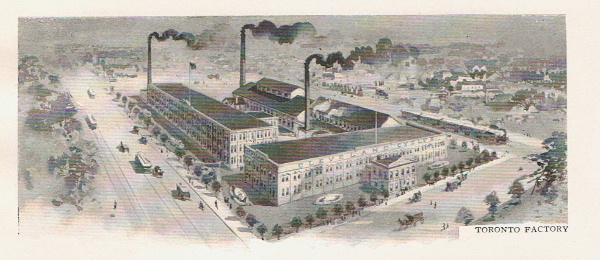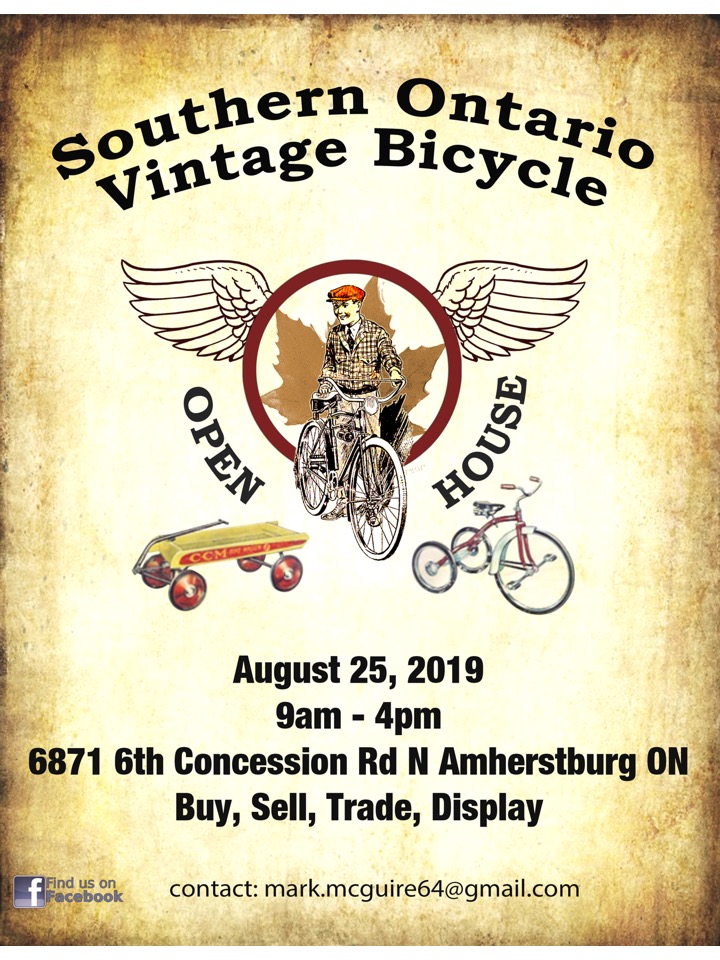Archives
Hello everyone:
For obvious reasons with the COVID19 situation, the CVBS Indoor show on March 29th has been cancelled. Very hard to say at this time if it will be rescheduled. At the moment we All must do our part. Let others know if you can.
Thank You & Take Good Care,
Jamie


From top left: Willie Spencer as a 15 year-old amateur, as the 1922
American sprint champion and as a promoter at Maple Leaf Gardens
Born November 11, 1895, in Manchester, England, William Gerald Spencer moved to Canada with his parents at the age of three. In 1910 he took up bicycle racing as a 15-year-old amateur. Blessed with a competitive edge and a keen sense of drama, by the time he was nineteen, it was said Willie Spencer had three things in life: a fiancé, $800 and a younger brother (Arthur) who had just won the Canadian Amateur Cycle Championship.
Arthur’s title and Willie’s confidence convinced the boys they could win big money by turning pro in the States. So, much to the chagrin of Willie’s girlfriend, in 1915 the Spencer boys took Willie’s money and headed to Newark, New Jersey, the North American centre for six-day bicycle racing.
The move paid off in 1917 when Willie won his first six-day race in San Francisco, CA., and Arthur won the American Sprint Championship, defeating perrennial champion Frank Kramer. Unfortunately, Arthur’s success did little to endear him to the American racing fans, who, seeing their beloved champion dethroned, hollered insults and catcalls at the Canadian rider, even going so far as to shower him with bags of peanuts, folded programs and empty water bottles.
It was a display that prompted Canada Cycle & Motor to send a letter to the newspaper admonishing the perpetrators: “Fans be fair, and watch Arthur’s attempts. Can’t you see he is fair, always on the square and trying? He proves his gameness by having a try in spite of all the booing and hissing.” [1]
Nor did Arthur’s victory stand him in good stead with racing promoter John Chapman. When Spencer asked for the same purse as Kramer would have gotten, Chapman balked at the demand, informing Spencer that nobody knew who he was.
As Australian racer Alf Goullet recalled it: “Arthur beat Kramer often that season. He accumulated the greatest number of points to take the crown. Everyone knew that one day someone would beat Kramer. Arthur Spencer finally did it. He was the new national professional sprint champion. But Chapman wouldn’t even give Arthur a contract for a single race. [2]
Spurred on by the hard time shown his brother, the 6 foot, 215 lbs. Willie Spencer stepped up and challenged Kramer to a grudge match. With most opponents considering Kramer to be unbeatable and avoiding his heat if at all possible, Willie created a sensation in May 1918 when he actually asked to ride against the American champion.
“I think he is the easiest man in the outfit to beat,” said Spencer. “He may have all the rest buffaloed, but he hasn’t got me.” [3]
Hearing of Spencer’s remark, an irate Kramer immediately demanded a $300 winner-take-all match race against the Canadian upstart. Willie Spencer seized the opportunity and beat Kramer in two straight heats.
 In August of that year the US Army drafted Willie for six months of military service. After his release from the army in January, Spencer continued racing, clocking victories around the world. During the 1919 racing season Willie Spencer won 18 of 23 match races in Philadelphia.
In August of that year the US Army drafted Willie for six months of military service. After his release from the army in January, Spencer continued racing, clocking victories around the world. During the 1919 racing season Willie Spencer won 18 of 23 match races in Philadelphia.
Despite his success, or because of it, Willie continued to encounter opposition south of the border. In June 1919, accused of using rough tactics against Kramer, he was suspended from racing at the Newark Velodrome, an action that again prompted CCM to come to their defense.
“It looks as if the Spencers, like other Canadian riders before them, have been up against a pretty hard proposition at Newark. It has been rumoured that a certain clique of riders constantly work together to block and pocket any rash outsider who comes up against them. As a rule they get away with this, but if the outsider makes the slightest endeavour to retaliate, he is immediately punished.” [4]
Ever the opportunist Willie Spencer used his ban in Newark to head to Europe, where his self-assurance and determination once again served him well. When promoters in Paris failed to come up with the kind of money Willie wanted, he turned to the local press.
“That afternoon,” recalled Willie, “I went down to a newspaper and found a sports writer who could speak a little English. I showed him my clipping book and told him I was here to ride in the Velodrome. I also told him that the opposition paper was going to use my picture (which it really was, although nobody knew it yet). And they photographed me from all angles.” [5]
With the next edition of both newspapers carrying front page photos of Willie, the promoters who had initially brushed him off now rushed to offer him a contract. Willie Spencer left Europe that year as the world indoor champion, and in 1920 headed to Australia where he set the world sprint record of twenty-five seconds for the quarter mile.

Willie Spencer lines up against New Zealand champion Phil O'Shea in 1925 at
Athletic Park in Wellington, N.Z.
Back in the States, however, Willie was still unable to come to terms with Chapman. Known as the "Czar of Cycling," John Chapman served as vice-president and general manager of Madison Square Garden, as well as the Newark Velodrome. While Chapman offered Willie $300 a race, Willie wanted $500. When Chapman failed to come up with the additional money, Willie headed back to Europe. In 1921 he returned to Paris where he won 15 of 22 races.
When Willie eventually returned to the States to compete, he captured the American Sprint Championship title in 1922, 1923 and 1926. At the time CCM was quick to point out that Willie's “championship bicycle was not made to order for him, but is a regular store model which other riders may obtain at a very moderate price, considering its championship quality.” [6]
Commuting between Paris, Berlin and New York, from 1923 until 1927 Willie Spencer and his CCM Flyer broke five world’s records and captured three American championships, but was never able to overcome the bad blood that existed between himself and Chapman. As a result, Spencer eventually took matters into his own hands.
 In September 1927 Willie drew $10,000 (in $50 bills) from his bank account and began to visit the homes of noted bicycle racers offering them contracts and cash bonuses to ride for him rather than for Chapman. By Sunday morning he had signed up twenty of America’s best cyclists, who, like himself, were fed up with the treatment accorded them by Chapman. That morning, with little to no sleep, Willie went to the Velodrome where he won the five mile race. When he went to collect his prize money at the box office, however, he discovered management was on to his endeavours.
In September 1927 Willie drew $10,000 (in $50 bills) from his bank account and began to visit the homes of noted bicycle racers offering them contracts and cash bonuses to ride for him rather than for Chapman. By Sunday morning he had signed up twenty of America’s best cyclists, who, like himself, were fed up with the treatment accorded them by Chapman. That morning, with little to no sleep, Willie went to the Velodrome where he won the five mile race. When he went to collect his prize money at the box office, however, he discovered management was on to his endeavours.
“They paid us riders and then closed the Velodrome. It never opened again,” said Willie. [7]
In all, Willie lured a third of the riders away from Chapman’s National Cycling Association, incl. top American riders Jimmy and Bobby Walthour. “Willie’s outlaws,” as they as they were dubbed by the American press, were led by a brash Canadian redhead by the name of Torchy Peden.
In the end, however, Chapman retaliated by banning Willie’s racers from riding at his venues including Madison Square Garden. With Chapman in control of most of the American racing facilities, in 1928 Willie headed back to Canada where he began to sponsor races at Toronto's Mutual Street Arena and then at Maple Leaf Gardens.
The same competitive spirit that drove Willie as a racer continued to motivate him as a promoter.
“Competition has given me something I wouldn’t sell for a million dollars: the will to win in everything I take on. I have found that second place is no good to me, in business as in racing,” said Willie. [8]
Over time there were those who worried about Spencer’s almost complete control over six-day bicycle racing in Canada. Dubbed the “boss monopolist,” Willie paid the riders, chose their teammates and, according to the hushed voices of some, told them who was to win.
Willie Spencer died October 2, 1963, at the age of 67. By that time he had returned to the States, where, in 1947, he became an American citizen. In Canadian Cyclist's ranking of the "Top 25 Canadian Cyclists of the Century" Willie Spencer was ranked number 5. In 2005 he was inducted into the United States Bicycling Hall of Fame. A champion the world over, Willie Spencer had been among the first to bring the CCM name to prominence.

1925 CCM Flyer, similar to Willie Spencer's, featuring a Major Taylor
stem, star racing pedals, banjo-type chain adjusters and striped
wooden rims.
[1] “Art Spencer Again Beats Frank Kramer,” VIM, Vol. 4, No. 2, October 15, 1917.
[2] Peter Joffre Nye, The Six-Day Bicycle Race: America’s Jazz-Age Sport (San Francisco: Cycle Publishing, 2006)
[3] “Willie Spencer Defeated Kramer,” Toronto Star, May 27, 1918
[4] “Art Spencer Again Beats Frank Kramer,” VIM, Vol.4, No.2, October 15, 1917.
[5] “The Formula For Fame,” VIM, Vol.37, No.1, 1950.
[6] “Willie Spencer Wins Cycling Championship on CCM Flyer,” Toronto Star, August 18, 1922.
[7] “The Formula For Fame,” VIM, Vol.37, No.1, 1950.
[8] “The Formula For Fame,” VIM, Vol.37, No.1, 1950.
YOU ARE INVITED TO THE ANNUAL XMAS SOCIAL
SUNDAY, DEC. 1, 2019
(PLEASE PRAY FOR GOOD WEATHER AS THERE IS NO BACK-UP DATE THIS YEAR)
TO BE HOSTED for THE WHEELMEN in CANADA
By
Captain Roger Tupper
TO BE HELD AT THE HOME OF THE MILTON HISTORICAL SOCIETY
WALDIE'S BLACKSMITH SHOP
16 JAMES ST.
MILTON, ON L9T 2 P4
905-875-4156
www.miltonhistoricalsociety.ca
INCLUDES A PRESENTATION
SCHEDULE
12:00 - DOORS OPEN. Please be there by at least 12:15
12:00 to 12:30 - MEET & GREET + getting the kitchen & tables organized.
12:30 to 1:30 - LUNCHEON and clean up
1:45 to 2:15 - SOCIAL + SHOW & TELL. Bring something new or old to show and
share. Chat and plan. Special meeting of the Liars Club to be held in the Grand Ballroom.
2:15 to 3:00 - SWAP MEET ~ BRING YOUR JUNQUE or TREASURES TO BUY, SELL or
TRADE. Bikes, Trikes, Ephemera, Parts, Accessories, Tools & Memorabilia
etc.
3:00 to 4:00 - OUR PRESENTATION
FOOD & BEVERAGES:
* PLEASE BRING A FOOD ITEM TO SHARE.
* ALCHOHOLIC BEVERAGES may NOT be consumed or brought into building.
* COFFEE & TEA will be supplied. If you wish sodas, fruit juice,
colas or whatever, please bring your own.
* SPECIAL FOOD REQUIREMENTS OR FOOD ALLERGIES ~ Please advise in advance.
SPECIAL NOTES:
* Our cost to rent the venue is $20 per hour. Our estimate is that at least 15 people will attend. Consequently we need to charge a "help pay for the rent" fee of $7.00 per person.
* Bring friends or family members. This is a great time to get involved. Everyone is invited. Why not bring a future nonmember of The Wheelman whom you might know? He/She might like to join. The more the merrier.
IMPORTANT
Please be so kind as to R.S.V.P. by Nov. 5th (however, the earlier the better). That would be much appreciated.
Kindly reply to: lorne-shields@rogers.com or leave a phone message at 905-886-6911
Best wishes,
Lorne Shields
COMMUNICATIONS
THE WHEELMEN in CANADA
Phone: 905 - 886 - 6911 (WITH Message taking capability)
Cellular: 416 - 568 - 5495 (NO Message taking capability)


The advent of the First World War (1914 - 1918) saw many battalions on bicycles rather than horses. Equipped in the same manner as the horse with a bed roll on the front and a rifle slung on its side, the bicycle was used by scouts, messengers, infantry men and even ambulance carriers.

At the outset of the war as the 1st Canadian Division began training at Valcartier, Quebec, it was decided that a cycle unit should be formed to carry out intelligence work with the Canadian Expeditionary Force. So it was that the 1st Canadian Cyclist Company sailed for England with the 1st Canadian Division on October 14 1914. Cyclist companies were also formed with the 2nd, 3rd and 4th Divisions and in May 1916 all four Divisional Cyclist companies were merged into the "Canadian Corps Cyclist Battalion."

Canadian Cyclist Corps. camped on Salisbury Plain 1914
Once in England the cyclists were trained in musketry and bayonet fighting, as well as signaling and topographical techniques. They carried out traffic control, sapping and mining, and served as trench guides, listening posts and battalion runners as well as dispatchers. Despite being hampered by the terrain and muddy conditions, bicycles were used to transport men and supplies over large distances and were said to be able to cover over 60 kms a day.

Allied cyclist scouts walking their bikes in the mud of war-torn France.
With a casualty rate of over twenty per cent, the bicycle corps. became known as a "suicide battalion" or "Gas Pipe Cavalry." One of the hardest hit units was the Newfoundland Regiment ninety per cent of whom were killed or injured at Beaumont - Hamel. Because of their courage, King George V gave the regiment the prefix "Royal" - the only time during the first World War that this honour was given.

The Newfoundland Regiment marching with their bicycles back to billet.
The individual responsible for supplying the Canadian military with bicycles was none other than Tommy Russell, general manager and soon to be president of CCM. Following a meeting on August 14, 1914, with the Minister of Militia and Defense, Colonel Sam Hughes , Russell was made an honourary Major and named purchasing agent for the Canadian Expeditionary Forces.

Demobilization begins as cyclists cross into Cologne.
A Canadian cyclist was the first Allied soldier to cross the Bonn bridge into Germany following the Armistice of November 1918.

Check out the photos: https://www.facebook.com/Southern-Ontario-Vintage-Bicycle-Open-House-540007036052649/

Like many nineteenth-century industrialists, Henry Abrahm Lozier started out selling sewing machines before turning his attention to bicycles. Based in Cleveland, Ohio, in 1891 Lozier bought a sewing machine factory in nearby Toledo for the purpose of manufacturing his "Cleveland" bIcycles. With his cycles quickly becoming known for their high quality, within a few years Lozier was among America's top bicycle makers, along with Augustus Pope (Columbia) and Victor Overman of the Western Wheel Works.
In 1895 Lozier established a branch plant in Canada on Weston Road in what was then known as the Toronto Junction. In charge of the plant was Lozier's brother-in-law Edwin R. Thomas. (When Lozier eventually sold his Canadian operation in 1899 to Canada Cycle & Motor, Thomas, who went on to develop the Thomas Flyer motor car, would become a director of Canada Cycle & Motor).

Claiming that their Cleveland bicycle was the finest bicycle that "money and brains" could produce, from the outset Thomas and H.A. Lozier & Co. were eager to lay down roots in their newly-adopted home.
We now issue our first catalogue to the Canadian public, and with pardonable pride we allude to the fact that, independent of the whole world, Canada now has a bicycle each piece and part of which is manufactured within the limits of its territory, by labour of its own, being distinctly Canadian, in fact the counterpart in every detail of wheels of the same name manufactured in the States, the reputation which is world-wide and popularity equaled by any bicycle.
Around the World on a CLeveland Bicycle, H.A. Lozier & Co. Ltd. Toronto, 1896
By the fall of 1896 the Lozier company was displaying its bicycles in the Carriage Building at the Toronto Industrial Exhibition (later the CNE) and had opened a riding school in Toronto's Granite Rink.
Below is an article written by a reporter from The Globe following a visit in April of 1896 to the Lozier factory at Toronto Junction.

MAKING BICYCLES
An Interesting Visit to the Lozier Company's Factory.
WONDERFUL MACHINERY
Defective Workmanship an Utter Impossibility
Superiority of Canadian Artisans - Strictly High Grade, Regardless of Cost, the Motto - A Boon to the Junction.
Amongst the many thousand bicyclists who, now that the wheeling season has arrived, are to be seen daily gliding along the streets and out in the suburbs of the city, there are few, if any, who give even a thought to what the production of one of these "noiseless steeds" costs. Pleased as they are with the speed, ease and grace with which they cover distance, their curiousity is swallowed up in satisfaction. They do not bother themselves in estimating the amount of brain energy necessary in making the close calculations required in the construction of these delicately fitted machines, nor do they trouble their minds with questions regarding the vast outlay of capital indispensable to a factory where a strictly first-class bicycle is manufactured. One reason for this is that probably not one in every thousand has ever seen the inside of a bicycle factory, "absolutely no admittance" being the rule enforced in nearly every establishment of the kind on the continent.
On one of the beautiful days of this week a representative of The Globe wheeled out to the Junction, and having heard the praises of the Clevelnad bicycle loudly sung on all sides, having been informed, too, that that establishment was employing 400 hands, and paying out very heavy sums in wages every month, he determined to avail himself of the opportunity of going over the institution, the Cleveland Company, contrary to the usual custom, being desirous that all who wish to do so should inspect their factory. This was a chance not to be lost of seeing a bicycle made from start to finish.
Arriving at the factory, which is just on the eastern outskirts of the town, the first person met was the active and energetic resident partner and General Manager, Mr. E.R. Thomas, who was in the act of issuing passes to several others bent on the same errand as the reporter. Procuring the necessary piece of pasteboard and a guide book, which the company has had printed for the convenience of those visiting the works, the visitors passed into the main factory building. This is divided into several departments, each one occupied to its fullest capacity with busy workers, and replete with the most modern and expensive machinery known in the art of bicycle construction, the cost of the plant and machinery alone in this factory being over $200,000.
Proceeding to the forging department, where the heavy thud of the ponderous drop-hammers and the roar of the oil furnaces produced a noise that was almost deafening, the first operations on the forged parts was seen. Here in the hands of deft and skilled mechanics the heavy solid steel bars, after being heated with the oil process , which has a toughening tendency, are beaten into the shape of sprockets, cranks, etc. Here is also seen the interesting process of braxing joints, all tempering ball cups, cones, chain blocks etc. The cranks are also tempered here, but undergo a different process, being first heated in molten lead and then immersed in a secret chemical solution of equalizing temperature.
In the next department some of the most wonderful machinery ever invented for the working of steel was seen in operation. Most of it is automatic in its operation, and some of it almost human. It is devoted to drilling crank hangers from solid steel forgings, profiling fork crown forgings and sprocket arms, milling chain blocks and sprockets, rolling handle bars, aluminum rims and blocks, and many other operations too numerous to mention. It is here where one gets the first idea of the enormous difference in the expense attending the manufacture of a strictly first-class wheel and one not up to that standard. Tools out of the best steel have to be graduated to as low as one-thousnadth of an inch, and on account of the accuracy required they have to be constantly renewed. It requires a very high order of intelligence to become a first-class toolmaker, and consequently high wages are paid. In the manufacture of the Clevelnad bicycle one toolmaker is employed for every wheel per day turned out, while in other factories, which manufacture cheaper grades, it is aid that one toolmaker is sufficient for every seven cyles produced per day.
Passing on, the many processes necessary to the making of a first-class chain is seen, and here the Cleveland people again spare no expense. After the chain is made it is put on an adjusting jack, which tests the rivets and makes the chain as pliable as a watch chain. The "jack" which is composed of four different-sized sprocket-wheels, revolves at the rate of about 300 revolutions per minute. it has a 1,000-pound weight attached, and a vibration strain of 400 pounds more; and even this severe test is not considered sufficient, because, before the chain is put on the wheel, it is subjected to what is known as a thousand pound jerk test.
The polishing room is another very interesting department, and is said to contain the most complete outfit in Canada. The sand blast system has just been added , which is used for polishing all the lighter parts, and is the only sand blast system in Canada. By this process the original strength of the parts is preserved, and it also does away with the process of "pickling," which is otherwise necessary, but considered by some experts to be injurious to the temper of the steel. Here, again, the firm decision of the management to make only the best, regardless of expense, is seen, as one man could polish more parts by the pickling process than seven can under the sand blast process.
The enamelling department was next inspected and proved most interesting. It contains twelve ovens, heated by oil; the heat is generated by a pressure of air of forty pounds to the square inch. In these ovens the enamel is baked on the parts, which is put on by the dip-tank system, thus insuring an even surface and perfect job. Four operations are necessary before the Cleveland's rich and durable finish is attained. Evidently no expense has been spared in the nickle-plating department, which alone is well worth a visit. It contains, besides the copper and nickle plating tanks, a 3,500-gallon dynamo, operated by a separate power. The reason for this is that it insures the process being kept going continuously, and thus gives ample time to make a good job.
The inspection department was next visited, and proved to be the most interesting of any yet seen, fully bearing out the assertion of the manager that it is "the crowning glory" of the Lozier factory. This is where the splendid reputation which the Cleveland wheel has won is maintained. It is claimed to be the most perfect inspecting department in the world. It is the most costly in the whole establishment, not so much in the wages of the large staff of expert inspectors employed, but in the waste of finished material, for such rigid inspection is almost incredible to those who have not seen it. From five to thirty-eight different operations are required on each part of the Cleveland bicycle. Each part, after each operation, must pass through this department, where it is rigidly guaged and tested upon special apparata.
The following might be given as an illustration - The sprockets are placed upon a fixture that is absolutely accurate as to the length of sprocket-arms, which have been previously tested. The spaces between the sprocket-teeth are guaged by a fixture so regulated by a needle that a deviation of two-thousandths of an inch, which is imperceptible to the eye, shows at the point of the needle a deviation of one-thirty-second of an inch, and causes the sprocket to be rejected as being defective. All cones, which are made of the very best tool steel, must come to a wrench fit. After being hardened by a secret process, they are again tested with a sharp-pointed prick punch, the slightest indentation causing them to be rejected. The inner links of the chain must come to two and one-half-thousandths of an inch, this guage limit being carried out in respect to the work in each department, and it is only those who are familiar with the production of interchangeable work who can form an idea of the enormous cost increase of the limit of variation.
Every part of the Cleveland bicycle, with the exception of the tubing, is made in the factory, by Canadian workmen, who, the Manager claims, are the best on the continent. No expense has been spared in looking after the comfort and health of the men, and each one feels that on him alone, by the exercise of all his talents, depends the success of the Junction's greatest enterprise.
On a fine afternoon no pleasanter or more instructive outing could be found than a visit to this complete factory. The city show-rooms are at 169 Yonge Street, and they have a riding school in connection. This school has been found too small for the large number who dail patronize it, and so the management has leased the Granite Rink for the summer months. This has been fitted up as a first-class riding school, and will be opened to-day.
The Globe, April 18, 1896.
The CVBS 6th Annual Winter Indoor Event went very well considering that the weather system we have been dealing with caused many to stay home.Still we had folks from Amherstburg, Kingston, Barrie, Trenton and many more places make the run to Brantford. This years event as always puts you with like minded people,and we have a great time Wheeling & Dealing. I have to stress again that it starts early and goes hard for 5-6 hrs and then we all pack up. I received some emails about this, as well some did not show until after 1pm.Thx to All who could attend, as we will be able to give the Stedman Community Hospice Brantford 400$.
Not too early to start your plans for our Big event,the CVBS18 2019 Sunday June 23rd, our 13th year at the beautiful Heritage View Farm.Hope to see you there.
Here are a few pics taken early Sunday.Best
Regards Jamie

















A LOOK BACK AT LAST YEAR




















